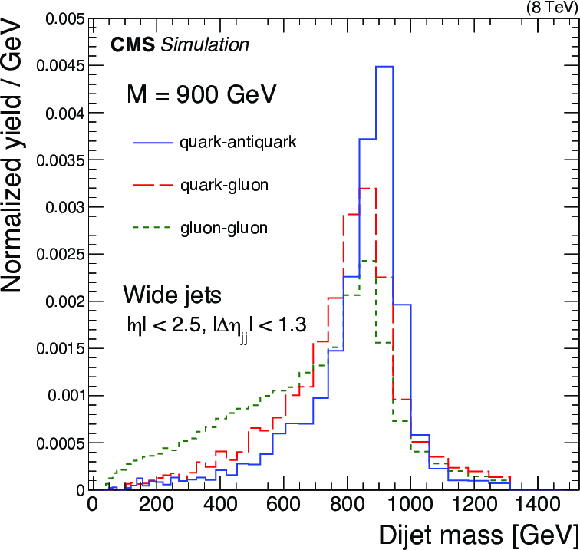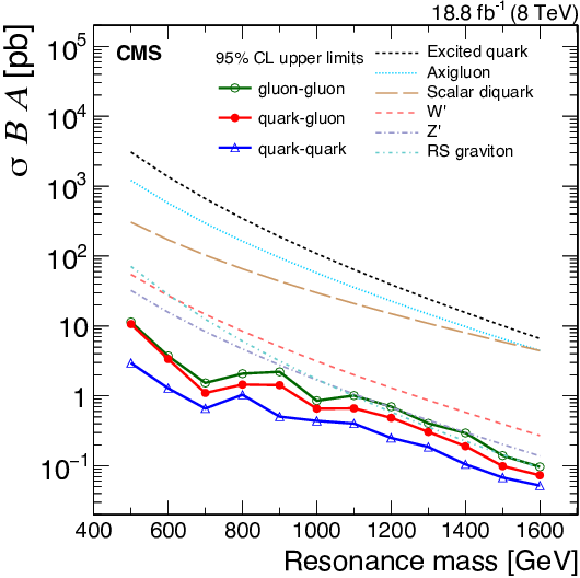

Compact Muon Solenoid
LHC, CERN
| CMS-EXO-14-005 ; CERN-EP-2016-090 | ||
| Search for narrow resonances in dijet final states at $\sqrt{s}= $ 8 TeV with the novel CMS technique of data scouting | ||
| CMS Collaboration | ||
| 30 April 2016 | ||
| Phys. Rev. Lett. 117 (2016) 031802 | ||
| Abstract: A search for narrow resonances decaying into dijet final states is performed on data from proton-proton collisions at a center-of-mass energy of 8 TeV, corresponding to an integrated luminosity of 18.8 fb$^{-1}$. The data were collected with the CMS detector using a novel technique called data scouting, in which the information associated with these selected events is much reduced, permitting collection of larger data samples. This technique enables CMS to record events containing jets at a rate of 1 kHz, by collecting the data from the high-level-trigger system. In this way, the sensitivity to low-mass resonances is increased significantly, allowing previously inaccessible couplings of new resonances to quarks and gluons to be probed. The resulting dijet mass distribution yields no evidence of narrow resonances. Upper limits are presented on the resonance cross sections as a function of mass, and compared with a variety of models predicting narrow resonances. The limits are translated into upper limits on the coupling of a leptophobic resonance $\mathrm{ Z }'_B$ to quarks, improving on the results obtained by previous experiments for the mass range from 500 to 800 GeV. | ||
| Links: e-print arXiv:1604.08907 [hep-ex] (PDF) ; CDS record ; inSPIRE record ; CADI line (restricted) ; | ||
| Figures | |

png pdf |
Figure 1:
The reconstructed dijet mass distribution (black points) fitted with the function of Eq. 1 (red solid line). The bottom panel compares the data and the fit result, normalized by the statistical uncertainty in the data, for each bin. The predicted distributions of narrow resonance signals for a hypothetical leptophobic resonance $\mathrm{ Z }'_B$ with two different mass and coupling values are shown in both panels (dash-dotted curves). This dijet mass distribution complements that observed at higher mass [19]. |

png pdf |
Figure 2:
The reconstructed dijet mass distributions for simulated RS gravitons decaying to quark-antiquark, excited quarks decaying to quark-gluon, and RS gravitons decaying to gluon-gluon, for a resonance mass of 900 GeV. |

png pdf |
Figure 3:
Observed 95% CL upper limits on $\sigma \mathcal {B}A$ for a narrow resonance decaying to gluon-gluon final states (open circles), quark-gluon final states (solid circles), and quark-quark final states (open triangles) compared with theoretical predictions for various resonance models. |

png pdf |
Figure 4:
Observed 95% CL upper limits on the coupling $g_B$ of a hypothetical leptophobic resonance $\mathrm{ Z }'_B \to \mathrm{ q } \mathrm{ \bar{q} } $ [21] as a function of its mass. The results from this study are compared to results obtained with similar searches at different collider energies [21,14]. |
| Tables | |

png pdf |
Table 1:
Observed upper limits at 95% CL on $\sigma \mathcal {B}A$ for resonances decaying to $\mathrm{ q } \mathrm{ q } $, $\mathrm{ q } \mathrm{g} $, and $\mathrm{g} \mathrm{g} $ final states as a function of the resonance mass. |
| Summary |
| In summary, a search for narrow resonances decaying into two jets was performed using data from proton-proton collisions recorded by the CMS experiment at $\sqrt{s}= $ 8 TeV, corresponding to an integrated luminosity of 18.8 fb$^{-1}$. The novel technique of data scouting was used; by reducing the information stored per event, multijet events could be collected in sufficiently large samples that a sensitive search for dijet resonances down to masses as low as 500 GeV was possible. No evidence for a narrow resonance is found. Model-independent upper limits on production cross sections are derived for quark-quark, quark-gluon, and gluon-gluon resonances. Based on these results, new limits are set on an extensive selection of narrow $s$-channel resonances over mass ranges not excluded by previous searches at hadron colliders. Bounds on the coupling of a hypothetical leptophobic resonance decaying to quark-antiquark are also provided, as a function of the resonance mass. The limits obtained are the most stringent to date in the dijet final state for narrow resonance masses between about 500 and 800 GeV. |
| References | ||||
| 1 | UA1 Collaboration | Two-jet mass distributions at the CERN proton-antiproton collider | PLB 209 (1988) 127 | |
| 2 | UA2 Collaboration | A measurement of two jet decays of the W and Z bosons at the CERN $ \bar{\rm{p}} \rm{p} $ collider | ZPC 49 (1991) 17 | |
| 3 | UA2 Collaboration | A search for new intermediate vector bosons and excited quarks decaying to two-jets at the CERN p$ \bar{\text{p}} $ collider | NPB 400 (1993) 3 | |
| 4 | CDF Collaboration | Two-jet invariant mass distribution at $ \sqrt{s}=1.8 $ TeV | PRD 41 (1990) 1722 | |
| 5 | CDF Collaboration | Search for quark compositeness, axigluons and heavy particles using the dijet invariant mass spectrum observed in $ p\bar{p} $ collisions | PRL 71 (1993) 2542 | |
| 6 | CDF Collaboration | Search for new particles decaying to dijets in $ p\bar{p} $ collisions at $ \sqrt{s} = 1.8 $ TeV | PRL 74 (1995) | hep-ex/9501001 |
| 7 | CDF Collaboration | Search for new particles decaying to dijets at CDF | PRD 55 (1997) 5263 | hep-ex/9702004 |
| 8 | CDF Collaboration | Search for new particles decaying into dijets in proton-antiproton collisions at $ \sqrt{s}= 1.96 $~$ TeV $ | PRD 79 (2009) 112002 | 0812.4036 |
| 9 | D0 Collaboration | Search for new particles in the two jet decay channel with the D0 detector | PRD 69 (2004) 111101 | hep-ex/0308033 |
| 10 | ATLAS Collaboration | Search for New Particles in Two-Jet Final States in 7 TeV Proton-Proton Collisions with the ATLAS Detector at the LHC | PRL 105 (2010) 161801 | 1008.2461 |
| 11 | ATLAS Collaboration | Search for New Physics in Dijet Mass and Angular Distributions in pp Collisions at $ \sqrt{s} = 7 $ TeV Measured with the ATLAS Detector | NJP 13 (2011) 053044 | 1103.3864 |
| 12 | ATLAS Collaboration | Search for new physics in the dijet mass distribution using 1 fb$ ^{-1} $ of pp collision data at $ \sqrt{s}= $7 TeV collected by the ATLAS detector | PLB 708 (2012) 37 | 1108.6311 |
| 13 | ATLAS Collaboration | ATLAS search for new phenomena in dijet mass and angular distributions using pp collisions at $ \sqrt{s}=7 $ TeV | JHEP 01 (2013) 029 | 1210.1718 |
| 14 | ATLAS Collaboration | Search for new phenomena in the dijet mass distribution using $ pp $ collision data at $ \sqrt{s}=8 $ TeV with the ATLAS detector | PRD 91 (2015) 052007 | 1407.1376 |
| 15 | CMS Collaboration | Search for Dijet Resonances in 7 TeV $ pp $ Collisions at CMS | PRL 105 (2010) 211801, [Erratum: PRL 106 029902] | CMS-EXO-10-010 1010.0203 |
| 16 | CMS Collaboration | Search for Resonances in the Dijet Mass Spectrum from 7 TeV pp Collisions at CMS | PLB 704 (2011) 123 | CMS-EXO-11-015 1107.4771 |
| 17 | CMS Collaboration | Search for narrow resonances and quantum black holes in inclusive and $ b $-tagged dijet mass spectra from pp collisions at $ \sqrt{s}=7 $ TeV | JHEP 01 (2013) 013 | CMS-EXO-11-094 1210.2387 |
| 18 | CMS Collaboration | Search for narrow resonances using the dijet mass spectrum in $ pp $ collisions at $ \sqrt{s}=8 $~TeV | PRD 87 (2013) 114015 | CMS-EXO-12-016 1302.4794 |
| 19 | CMS Collaboration | Search for resonances and quantum black holes using dijet mass spectra in proton-proton collisions at $ \sqrt{s} = $ 8 TeV | PRD 91 (2015) 052009 | CMS-EXO-12-059 1501.04198 |
| 20 | R. M. Harris and K. Kousouris | Searches for Dijet Resonances at Hadron Colliders | IJMPA 26 (2011) 5005 | 1110.5302 |
| 21 | B. A. Dobrescu and F. Yu | Coupling-mass mapping of dijet peak searches | PRD 88 (2013) 035021 | |
| 22 | C. Collaboration | Data Parking and Data Scouting at the CMS Experiment | CMS-DP-2012-022 | |
| 23 | S. Benson, V. Gligorov, M. A. Vesterinen, and J. M. Williams | The LHCb Turbo Stream | in 21st Int. Conf. on Computing in High Energy and Nuclear Physics (CHEP2015) | |
| 24 | CMS Collaboration | The CMS experiment at the CERN LHC | JINST 3 (2008) S08004 | CMS-00-001 |
| 25 | M. Cacciari, G. P. Salam, and G. Soyez | FastJet user manual | EPJC 72 (2012) 1896 | 1111.6097 |
| 26 | M. Cacciari, G. P. Salam, and G. Soyez | The anti-$ k_t $ jet clustering algorithm | JHEP 04 (2008) 063 | 0802.1189 |
| 27 | CMS Collaboration | Determination of jet energy calibration and transverse momentum resolution in CMS | JINST 6 (2011) P11002 | CMS-JME-10-011 1107.4277 |
| 28 | M. Cacciari and G. P. Salam | Pileup subtraction using jet areas | PLB 659 (2008) 119 | 0707.1378 |
| 29 | L. Randall and R. Sundrum | An alternative to compactification | PRL 83 (1999) 4690 | hep-th/9906064 |
| 30 | U. Baur, I. Hinchliffe, and D. Zeppenfeld | Excited quark production at hadron colliders | IJMPA 2 (1987) 1285 | |
| 31 | U. Baur, M. Spira, and P. M. Zerwas | Excited Quark and Lepton Production at Hadron Colliders | PRD 42 (1990) 815 | |
| 32 | T. Sj\"ostrand, S. Mrenna, and P. Skands | A brief introduction to PYTHIA 8.1 | CPC 178 (2008) 852 | 0710.3820 |
| 33 | R. Corke and T. Sj\"ostrand | Interleaved parton showers and tuning prospects | JHEP 03 (2011) 032 | 1011.1759 |
| 34 | GEANT4 Collaboration | GEANT4---a simulation toolkit | NIMA 506 (2003) 250 | |
| 35 | Particle Data Group, K. A. Olive et al. | Review of Particle Physics | CPC 38 (2014) 090001 | |
| 36 | CMS Collaboration | CMS Luminosity Based on Pixel Cluster Counting - Summer 2013 Update | CMS-PAS-LUM-13-001 | CMS-PAS-LUM-13-001 |
| 37 | P. H. Frampton and S. L. Glashow | Chiral color: an alternative to the standard model | PLB 190 (1987) 157 | |
| 38 | R. S. Chivukula, A. Farzinnia, J. Ren, and E. H. Simmons | Hadron collider production of massive color-octet vector bosons at next-to-leading order | PRD 87 (2013) 094011 | 1303.1120 |
| 39 | J. L. Hewett and T. G. Rizzo | Low-energy phenomenology of superstring inspired E(6) models | PR 183 (1989) 193 | |
| 40 | E. Eichten, I. Hinchliffe, K. D. Lane, and C. Quigg | Supercollider physics | RMP 56 (1984) 579 [Erratum: RMP 58 1065] | |
| 41 | J. Pumplin et al. | New generation of parton distributions with uncertainties from global QCD analysis | JHEP 07 (2002) 012 | hep-ph/0201195 |

|
Compact Muon Solenoid LHC, CERN |

|

|

|

|

|

|